|
I'll freely admit that in spite of my ghoulish interest in American serial killer cases of years past, until very recently I was unaware of the series of killings that took place in 1946 over a three month period in the town of Texarkana on the Texas/Arkansas border, crimes committed under the cover of darkness that became known as the Texarkana Moonlight Murders. They were carried out by a man wearing a cloth mask with holes cut out for his eyes, and despite the Texas Rangers – including the widely respected M.T. 'Lone Wolf' Gonzaullas – becoming involved in the hunt for the perpetrator, he was never caught. Over time he became known as 'The Phantom Killer'.
Now I'd love to claim that I came across this case in the course of academic research, but it was actually through the 1976 drive-in thriller under examination here, a film I'd also been previously unaware of until the press release announcement for this very disc landed in my inbox. Having watched the film, I was keen to find out more about the events that inspired it and set about researching and reading up on them, in part to see how faithful the filmmakers had been to the facts. As it turns out, this particular aspect is covered by the key extra feature on this very disc, but I'll get to that later.
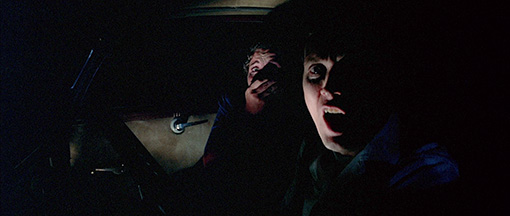
From the moment it begins, the film kicks resolutely against the expectation that it's going to play as a sensationalist exploitation flick, opening instead with a handsomely shot, scene-setting montage that portrays Texarkana as a happy and aspirational post-war community, as factual information on the time and place is outlined in soberly delivered narration, which then shifts in tone to provide a portent of things to come. The story proper kicks off when Samuel Fuller (is this a deliberate movie reference?) and Linda Mae Jenkins drive out to Lovers' Lane so that Sammy can try it on for the umpteenth time with his resistant girlfriend. His efforts are interrupted when a man with a sackcloth over his head appears out of the dark and disables their car, pulls Sammy out through the window and beats him senseless, then climbs into the vehicle to do who knows what to Linda Mae. Surprisingly (at least for those without knowledge of the case on which the film is based) both of the victims survive their ordeal, and at the hospital the attending doctor reveals that Linda Mae's back, stomach and breasts have been heavily bitten. I have no way of knowing if David Fincher is a fan of this film, but it's hard not to see this sequence as a dry run for the similarly set and toned opening scene of Zodiac.
Even here director Charles B. Pierce doesn't overplay his hand or attempt to make a recyclable movie monster out of the Phantom – the fact that Sammy has been given a serious beating is only revealed at the hospital, and Pierce ends the scene just seconds before the onset of the assault on Linda Mae. Her screams, meanwhile, are those of a genuinely terrified woman, and when she is discovered bleeding and incoherent by the side of the road the following morning, actress Christine Ellsworth is so grimly convincing that – despite the fact that we've only just met her and are a mere nine minutes into the film – you really do feel for what Linda Mae must have gone through.
This air of sober realism is carried through into the scene that immediately follows, as Deputy Norman Ramsey (a very good Andrew Prine) sends an ambulance up to help the injured Sammy with a slap on its side and an urgent shout of "Go!" and radios in the details of the attack, and is continued at the hospital as the nature of the couple's injuries are outlined to the astonished policemen. It's a little after this that something happens that... well, I'll get to that in a minute.
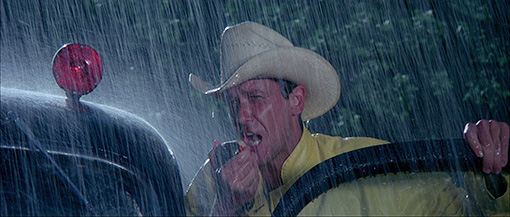
Scooting forward almost invisibly to 3 weeks later, a new date caption and the narrator identifying a couple by name signal to us that these two are not going to have a pleasant evening. Given that this is the first time the victims are killed, the movie wrong-foots us again by completely sidestepping the murders themselves and showing us only their aftermath, discovered by Ramsey when stumbles on something suspicious while patrolling Lovers' Lane. The third attack, on the other hand, is shown in its entirety and is the one that those who've seen the film tend to recall first. Its notoriety springs from the ghoulishly creative method employed by The Phantom to kill his female victim and for many it's the film's most disturbing sequence. It's also one that inadvertently anticipates a key element of the splatter sub-genre to come, which tended to trade on the colourful manner in which the victims were dispatched.
The fourth attack is the most protracted and nail-biting, and also happens to be the one that sticks most closely to the known facts. Despite faithfully recreating the timeline and basic essentials of the assaults and sporting an opening proclamation that assures us "the story you are about to see is true, where it happened and how it happened" and that "only the names have been changed," the film does play a few creative games with the details. That the arrival of M.T. Gonzaullas stand-in J.D. Morales (played with appropriate authority and colour by Ben Johnson) and the point at which the townsfolk began hiding behind closed doors and arming themselves up have both been brought forward does make a degree of storytelling sense. What is surprising is that the specifics of how most of the attacks took place have been altered, an odd decision given the authenticity elsewhere and the considerable mileage for tension and horror there would be in showing what actually took place. Not that it ultimately matters in movie terms – so grounded in reality do these sequences feel that it's oddly easy to believe this is actually how the events really played out.
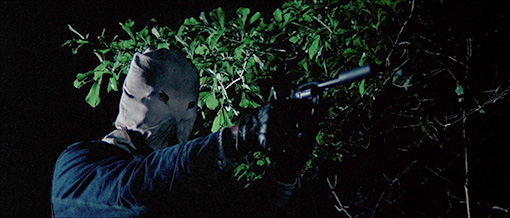
It's a grippingly told tale, one whose period setting, low key performances and sometimes quasi-documentary feel give it an air of class that belies what was likely not the biggest of budgets. There's an engagingly old-school feel to the move-along pacing and the sometimes inventive economy of the filmmaking (a wide shot of frightened townspeople panic-buying guns cuts to a static shot of a gunsmith's shelf sporting a single revolver), and the decision to reveal the killer's presence by focussing on his feet allows Pierce to put him in public places and mix with those who might become his next victims without ever having to speculate on his identity.
It's thus hard to understand quite why Pierce then chose intermittently break the spell with some ill thought-out comedy relief featuring himself as patrolman 'Sparkplug' Benson. It's not just that these sequences disrupt the flow and undermine the film's underlying sense of realism, the simple fact is that they're not particularly funny. Actually, for the most part they're not remotely funny. And while the likelihood is that they were intended to give the audience some respite from the film's darker elements, they really do stick out like freshly hammered sore thumbs. Thus when the cops track down a possible suspect for the killings, the tension and intrigue of the scene is undercut by shots of Morales and Ramsey holding on for dear life as Sparkplug throws their car around dangerous turns (complete with slow motion skids) and propels them into a lake as if auditioning for a remake of It's a Mad, Mad, Mad, Mad World.
But ultimately the scenes in question do no serious harm to what is otherwise a gem of a rediscovery. Made in the early days of the 70s American indie horror revival (post-Night of the Living Dead, pre-Halloween), the film's period setting, air of low-key realism, sympathy for the victims and focus on the efforts to catch the killer almost cancel out its horror credentials and see it reclassified as a crime thriller. Misfired comedy aside, it's a damned fine achievement, whichever genre badge you choose to pin to its chest.
OK, the first thing to note is that there are still quite a few dusts spots on this transfer and the odd small, frame-long blip of damage, though it is worth noting that this is in no way constant and some scenes are almost free of specks. But that's my only real gripe. In all other respects this is a very fine transfer, with a warm colour palette, decently graded contrast, crisply rendered detail and a richness I still associate solely with 35mm film. The black levels are deep and inky, which really helps to make the night feel full of hidden dangers, though does make a handful of unconvincing day-for-night shots stand out all the more. Intermittently there are close-ups where the sharpness softens, and I'm guessing that this was a slight focus issue at the filming stage due to working at speed with a sometimes narrow depth of field – on a couple of occasions the faces are very slightly soft while a collar or shoulder button appears to be in focus. The wide shots are almost always gorgeous and the opening montage of town life looks absolutely ravishing.
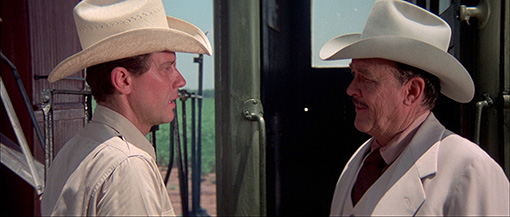
The linear PCM 2.0 mono track is clean of damage and has no distortion or distracting background hiss or crackle. Inevitably, there are some range restrictions resulting in a slightly tinny edge to the narration and little in the way of bass, but it gets the job done.
All of the extra features here appear to have been licensed from the US Blu-ray release from Shout! Factory. This, I should point out, is no bad thing.
Commentary
Having spent some time researching and reading up on the true-life case to re-watch the film with an eye for the games it plays with the facts, I was given cause to quietly bang my head on the table when I sat down for a commentary that rendered much of that legwork unnecessary. Justin Beaham plays host to Pulitzer Prize-nominated author and historian Dr. James Presley, a Texarkana local and author of the definitive book on the case, The Phantom Killer. Although there is some discussion on the film, the lead actors and director Charles B. Pierce – about which surprisingly little is known – the two men focus largely on the facts and how they have been interpreted by the film. The specifics of how the attacks were carried out are provided, and while this does tend to highlight when the film gets a little creative with the truth, it also brings home how much of what plays out here is on the nose. I was oddly pleased to learn that Texas Ranger M.T. Gonzales was apparently happy with how he was portrayed in the film.
Theatrical Trailer (2:21)
A narration-led and documentary-styled trailer with a slightly fluffy picture and a crackly soundtrack, which opens by outlining the fate of each of the victims (way to go on the spoilers, guys) and includes some of the establishing shots from the opening sequence, which emphasises just how good this new transfer is at its best.
2014 Remake Trailer (2:22)
Sporting the new Metrodome logo (it's they who have released it on UK DVD), this trailer sells what is actually more of a sequel than a remake as a well-shot slasher, which it may well be (I have yet to see it).
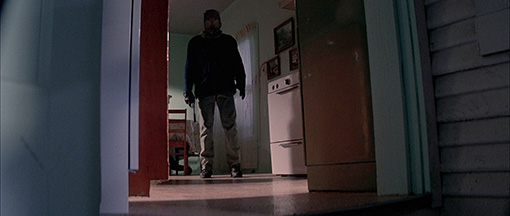
Small Town Lawman – An Interview with Actor Andrew Prine (9:41)
The colourful and upbeat Andrew Prine assures us that he regards every film he's worked on as a positive experience, describes director Pierce as "a complete wild man" and recalls spending lots of time with him chasing women and occasionally breaking off to make movies. He salutes Ben Johnson as one of cinema's best ever cowboy actors, and a little unfairly states that Dawn Wells was "more beautiful than the film deserved." He also claims to have written the film's finale because the script had no ending.
Survivor Stories – An Interview with Actress Dawn Wells (5:17)
Talking at a speed that I'm guessing would be nigh-on impossible to accurately subtitle for foreign markets, the enthusiastic Wells recalls being asked by Pierce to take the role at short notice and talks about shooting the scene in which her character is attacked.
Eye Of The Beholder – An Interview With Director Of Photography James Roberson (12:33)
Roberson talks about first hooking up with director Pierce (for whom he also shot Winterhawk, The Winds of Autumn and Grayeagle) and specifically the shooting of The Town That Dreaded Sundown, a task he had to undertake with his foot in a plaster cast. He paints a very positive picture of the local people ("You can shoot at my house but you've got to stay for dinner") and recalls how Ben Johnson dealt with a young actor who was loudly insulting a female crew member. His story about how he became a film cameraman almost by chance will likely leave anyone struggling to break into the film industry goggle-eyed with envy.
Also included is a limited edition Collector's Booklet featuring new writing by critic Mike Sutton, reproductions of original Sundown ephemera, illustrated throughout with production stills, but this was not available for review.
Though I could live without the misplaced attempts at comedy, this is still a solidly handled, soberly pitched and compelling horror-thriller that may play a few small games with facts, but it is still more faithful to the case that inspired it than a good many films flying the based-on-true-story flag are to their source material. Dust spots aside, the transfer on Eureka's Blu-ray is very impressive, the interviews interesting, and the commentary a goldmine of factual information. Recommended.
|